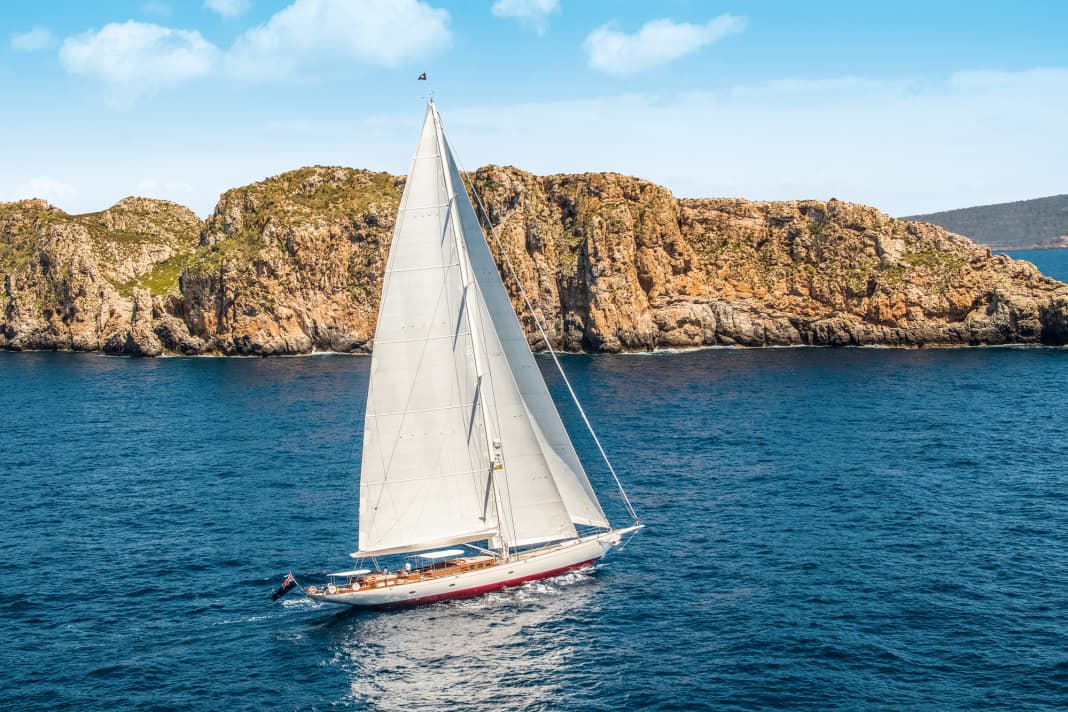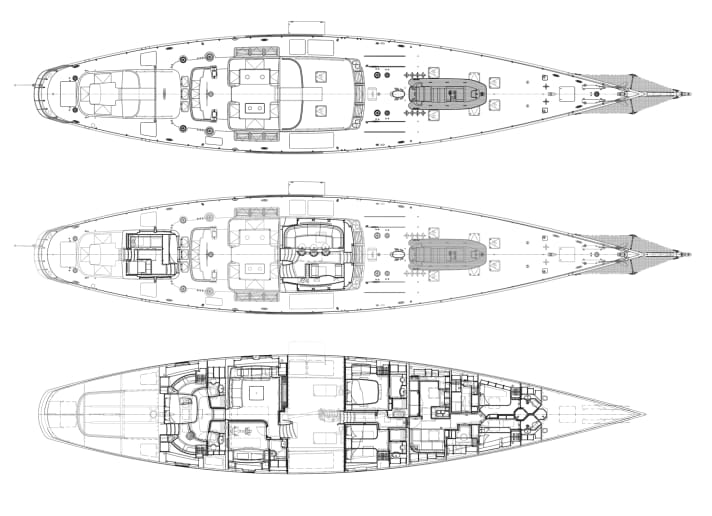"Vijonara": Sailing family fulfils a lifelong dream with a 42-metre slipway
Martin Hager
· 20.05.2023






Mallorca is undoubtedly one of the most pleasant and beautiful sailing areas for large yachts during the summer months. It is not without reason that the marinas on the Balearic island are bursting at the seams from June to the end of August. Those who manage to get a berth at the sporty Real Club Náutico de Palma, the more cosy Club de Mar, the slightly sophisticated Portals Nous or the exclusive Port Adriano can count themselves lucky.
"You can rely on the daily thermals," assures "Vijonara" captain James Box as we meet at ten o'clock in the morning in bright sunshine at the berth of the latest Pendennis new-build at the STP dock. Servicios Técnicos Portuarios, or STP for short, is a familiar name to any yachtie. The shipyard, which has huge dock areas in the immediate vicinity of Palma de Mallorca's old town, not only carries out extensive refits on its own, but also rents out work space to shipyards such as Pendennis. "We have had a permanent base here since 2011 so that we can offer our customers the best possible service and repairs at short notice, even in the Mediterranean," explains Michael Rusbridge, who accompanied the construction of "Vijonara" as project manager at Pendennis. "The 42-metre sloop was only recently delivered, and before the owners start their extended voyages, we are still working through a few warranty points."
However, the small jobs on the elegant Truly Classic, a brand name by designer André Hoek, are paused for a day, as a sailing day with BOOTE EXCLUSIV is on the programme. "We still have a bit of time, the wind doesn't pick up until 1 pm," says the captain. While the land heats up and the sea breeze builds up at a leisurely pace, we use the time with Michael Rusbridge for a tour on board.
A dream comes true with "Vijonara"
"It was great fun building 'Vijonara'," says the project manager. "The Swiss owners have been enthusiastic sailors for many years, and they had very specific ideas about their dream yacht." However, the dream of classic lines paired with a modern and efficient underwater hull did not grow overnight. "'Vijonara' is our fifth sailing yacht," says the owner. "My wife and I have been passionate sailors since our student days. We learnt how to sail properly on the Baltic Sea during the GDR era. Not an easy endeavour! We longed for freedom and eventually fled the state under sometimes dramatic circumstances. In the years that followed, we explored the Baltic Sea extensively on our Dehler 41 until we finally broadened our sailing horizons with areas around the Balearic Islands. Our last sailing boat, a twelve-metre Tofinou, is still moored here today. With our fifth yacht, we then jumped from 41 feet to 42 metres - a huge step and the fulfilment of a lifelong dream!"
The inspiration for the construction of the second Truly Classic 128 came from an extensive article about the 37 metre long "Pumula" from Royal Huisman Halls. "As soon as I saw it, I liked the classic lines and the aft deckhouse with direct access to the owner's cabin," says the owner. The idea of a new yacht was born. To get a more precise idea, several charter trips followed and finally appointments with yacht designers. The sailing couple met designer André Hoek, known for his classic designs, on board "Atalante", the first Truly Classic 128 built by Claasen in Holland. "The chemistry was right straight away and we felt we were in good hands with the team introduced to us, which also included the owner's representatives Peter Wilson and Nigel Ingram from MCM Management." A charter trip on "Atalante" followed and helped to concretise the ideas.
Furnishings in white colour and wood
"The owners ultimately opted for a completely independent layout, customised to their needs," says project manager Rusbridge. The core decisions around which Hoek realised the layout included a helm station and working cockpit amidships and an aft cockpit that leads directly into the owner's area, as on "Pumula". This consists of a spacious suite that extends over two levels thanks to the aft deckhouse. "I want to spend as much time on board as possible, so it's inevitable that I also have to work while travelling. The aft deckhouse serves as my study, probably the most comfortable one I've ever had," says the owner. A few steps below is the queen-size bed with a neighbouring seating area and an Oculus hidden in the coffee table. "The owners were inspired by a table like the one the owner of the Royal Huisman ketch "Elfje" had installed. A round window in the hull allows a view into Nemo's realm. "Four 15-millimetre-thick glass laminates ensure that the water does not flood the yacht," says Rusbridge. In front of the owner's suite on the port side is the oversized lower saloon and opposite a gym, which can be converted into a guest cabin in a few simple steps if required. The owner couple took a classic approach to the choice of materials. Most of the furniture is made of mahogany, while the floors are made of European walnut. White wall and ceiling panels nevertheless lend the rooms a generous visual expanse. Special features of the interior design include ubiquitous furniture and leather details from the saddlery and leather professionals at Hermès.
"One of my favourite pieces on board is the wall-sized leather map of the world in the lower saloon, in which our travel routes are to be embroidered every year," says the owner. From the Baltic Sea around the world - a wonderful story. In the centre of the yacht is the upper saloon with a dining table on the port side and a cosy lounge area opposite. A few steps towards the bow, guests can make themselves comfortable in two spacious cabins. The crew quarters are quite compact for a maximum crew of four and include a galley, laundry, mess room and two lockers. The navigation corner, which also serves as the captain's office, is particularly small. While we are still busy with the decor details, preparations for departure begin on deck. Although the 355-kilowatt Scania main engine is already running, the interior is surprisingly quiet. "The owners attached particular importance to excellent sound insulation," explains the project manager. The inside of the hull was sprayed with a sound-absorbing paint, and the yacht builders chose an efficient variant with a rubber core for the rock wool insulation.
Helping hands for sailing with "Vijonara"
On deck, we are overcome with the joyful realisation that the Mallorcan afternoon breeze really can be relied upon. The sun is shining, the thermometer reads 30 degrees in the shade and a gentle ten-knot breeze is blowing from the south-west across the bay of Palma. "We've brought some friends on board to help us today, as there have to be at least three of us to sail," explains Captain James as he confidently manoeuvres "Vijonara" out of the STP box. The owner opted for a traditional mainsail on a Park Avenue boom rather than the usual inboom furling system for yachts of this size. "However, this means that we need all hands on deck, including the owner, to set and hoist the sails," explains James Box, while deckhand Dan Marks climbs into the overhanging boom to keep an eye on the Harken sledges when setting the sails. While "Vijonara" moves leisurely out of the harbour entrance, within two minutes the belly-trimmed Doyle laminate mainsail is up on the carbon mast of Southern Spars. James Box drops a few degrees, the 404-square-metre main fills up and 150 tonnes of "Vijonara" lies gently on its side. And the staysail sheets are already laid around the Lewmar winches. "Are you ready to set the staysail?" At the touch of a button, Captain Box operates the hydraulic Reckmann furlers, and within ten seconds another 156 square metres are in the wind. The B&G instruments are now showing 18 knots of true wind, and the log is levelling out at 10.5 knots SOG. Supersailors were invented for days like this. Constant, warm wind in the perfect strength to play with the entire sailing wardrobe. "Are you ready to set the Yankee?" Box calls out to the cheerful group of sailors. The furlers set the Yankee drum in motion, and a few seconds later another 319 square metres of laminate accelerate the Truly Classic Slup to 13 knots. "When we sail the Yankee and staysail, we also set the runners to better distribute the rig forces," explains James Box, handing me the steering wheel. An unexpected amount of force is required to turn the wheel and keep the slip on course. The rudder pressure is amazing and impressively conveys the forces generated by 879 square metres of wind.
The end of the bay is reached far too quickly and Cala Blava beach seems close enough to touch. Time for a tack and a beat towards Magaluf. As with all yachts with staysails, the yankee sail must be furled before tacking. At the push of a button, the oil-pressure-controlled furlers furl the triangle. "Are you ready to tack?" And I'm already steering the nimble sloop through the wind on a half-wind course. With Yankee and staysail and a 15-degree heel, we plough towards the north-west until we can go no further. One more tack and four hours are up, it's time to sail back towards Palma. The last few nautical miles offer another highlight: the Yankee and staysail give way to the 1153 square metre A2 gennaker, which has been tied to the bowsprit waiting to be used as a space sheet. The giant white sheet fills up in no time and we glide downwind towards the mooring at eleven knots SOG. To make the sailing day perfect, a school of dolphins follows us for the last few nautical miles to just outside the harbour entrance. Playmates with taste.
A disadvantage of the classic mainsail setup
We sail into the harbour under main only, and in increasingly gusty winds, a disadvantage of the classic mainsail set-up becomes apparent: while deckhand Dan keeps "Vijonara" upwind under engine power, the captain gymnastics around in the Park Avenue boom and neatly folds the heavy main laminate - anything but an easy task despite lazyjacks, which costs sweat and nerves in high winds. "Inboom systems are technically more vulnerable, which is why the owner opted for the tried-and-tested mainsail variant that he was familiar with," says Michael Rusbridge. "What's more, he enjoys being involved in every manoeuvre himself." It is not without reason that sailing is considered a sport, a fact that is often forgotten today with the numerous electrical and hydraulic auxiliary systems on board. However, anyone who has ever shot out the 50 metre long genoa sheet of a supersailor knows what we are talking about.
For the "Vijonara" owners, things are continuing at a leisurely pace. The round-the-world trip is slowly approaching, and until then there are still Mediterranean cruises and the odd fun regatta on the agenda.
Technical data
- Length over everything: 42,24 m
- LWL: 27,29 m
- Width: 7,72 m
- Depth: 4,50 m
- Displacement (empty):150 t
- Ballast: 41 t
- Material:Aluminium
- Motor: 1x Scania DI13
- Engine power:1x 355 kW
- Rigging: Southern Spars, Carbon
- Sail: Doyle Stratis
- Sail area (on the wind): 879 square metres
- Sail area (outhaul): 1,157 square metres
- Winches: Harken, Lewmar
- Furler: Reckmann
- Galley: Miele
- Leather: Hermès
- Owner representation: MCM
- Interior design: Hoek Design
- Construction:Hoek Design
- Classification: ABS
- Shipyard: Pendennis, 2017

This article appeared in BOOTE EXCLUSIV issue 06/2018 and was revised by the editorial team in May 2023.

